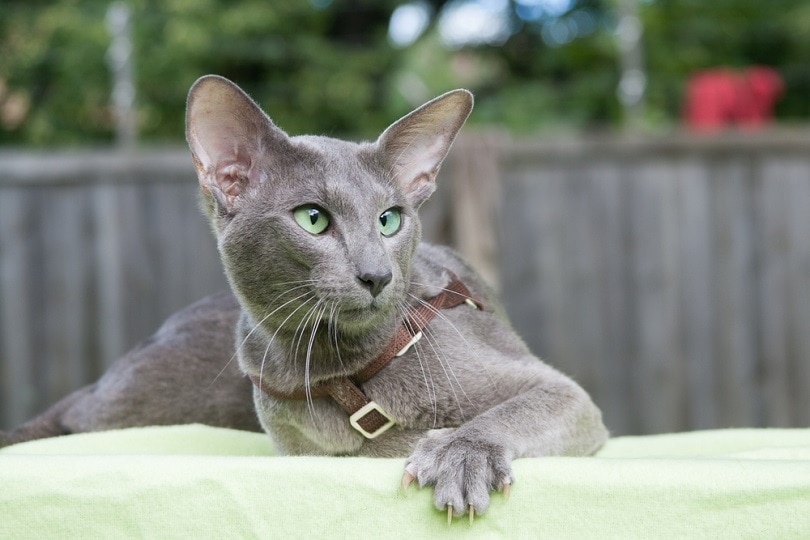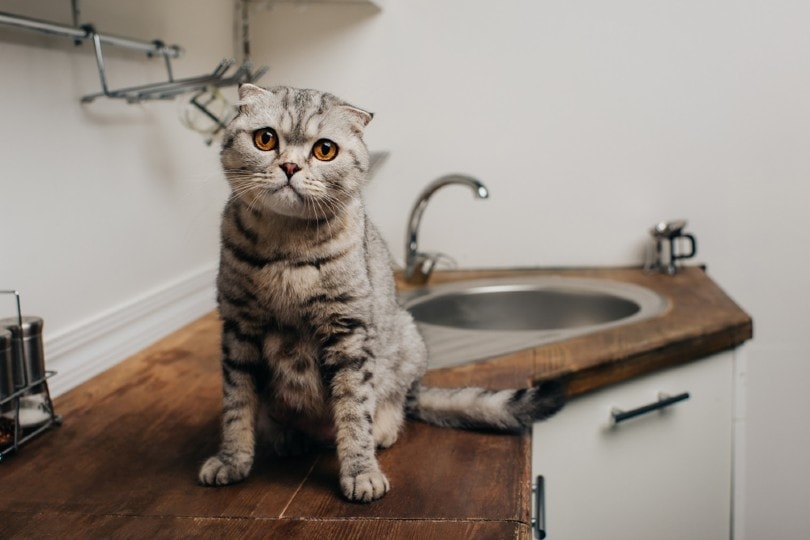11 Types of Grey and White Cat Breeds: Pictures, Facts & History
Updated on

Cats come in many different sizes, breeds, patterns, and colors, but one of the most common color combinations you’ll find is grey and white. This beautiful color blend is known as “bicolor” and is marked by white fur being combined with fur of another color.
While there are many different cat breeds with this color combo, today we’re going to take a look at the 11 most common. If you know you want to adopt a grey and white cat in the future, use our guide to find the breed that speaks to you the most.
The 11 Grey and White Cat Breeds
1. British Shorthair

| Average lifespan: | 12–17 years |
| Energy level: | Moderate |
| Personality traits: | Easy-going, affectionate, undemanding |
The British Shorthair is an adaptable and affectionate companion. Most don’t wind up being a lap cat, but they do love to sit beside you and know that you’re close by. This breed can grow to be rather large, with healthy males weighing up to 20 pounds.
The British Shorthair is very laidback, but don’t confuse their chill demeanor with a lack of intelligence. They are very smart so be sure to provide plenty of engaging puzzle toys and lots of treats when they learn how to use them.
2. Cornish Rex

| Average lifespan: | 11–15 years |
| Energy level: | High |
| Personality traits: | Playful, vocal, intelligent |
The Cornish Rex has a very striking and unique appearance. Their curly whiskers and wiry coat are the product of a natural mutation and are what sets them apart from many other cat breeds. These cats are very smart and highly active so they always want to be at the center of everything going on in the household. They’ll climb to the highest point in a room so they can keep watch on what’s going on.
Most Cornish Rex kittens won’t grow to become quiet lap cats. They tend to be very vocal and articulate through their glances and gestures.
3. Devon Rex

| Average lifespan: | 9–15 years |
| Energy level: | High |
| Personality traits: | Outgoing, intelligent, mischievous |
The Devon Rex is a cousin to the Cornish Rex. They look similar in many ways, but a Devon Rex coat has a looser curl than that of its cousin. Their huge ears give them an elfin appearance that makes them unique to other breeds. This breed is highly intelligent and needs constant challenges and stimulation. They can learn and perform tricks and love playing games like fetch.
The Devon Rex is a family-friendly pet who you may find injecting himself at the dinner table for meals. He loves attention from his family but is welcoming to new people, too.
4. Persian

| Average lifespan: | 10–15 years |
| Energy level: | Low |
| Personality traits: | Quiet, sweet, affectionate |
The Persian is a beautiful cat and always makes the list of the most popular pedigreed breeds. Many might think that its glamorous and elegant appearance would make this breed snooty, but that couldn’t be further from the truth.
Persians are known for their sweet and docile personalities. While they are higher in maintenance due to their long coats and are prone to some health issues, you’d be hard-pressed to find a more loving and loyal cat. Persians are a very gentle breed that prefers a quiet and predictable environment. They’ll choose your lap over a high perching spot any day.
5. European Shorthair

| Average lifespan: | 15–20 years |
| Energy level: | Moderate to high |
| Personality traits: | Intelligent, athletic, loyal |
European Shorthairs are a natural breed that came to be without any intervention from humans. Many cat experts believe they are the original house cat since they began to be domesticated thousands of years ago.
This breed adapts quickly to changing environments, which makes them a top choice for growing families or households with several types of animals. European Shorthairs are eager to please their humans, a trait that can be traced back to their European heritage when they were hardworking mousers.
This breed provides the perfect balance between loyal and playful.
6. Oriental

| Average lifespan: | 8–12 years |
| Energy level: | High |
| Personality traits: | Loyal, mischievous, social |
The Oriental Bicolor is a mix between the American Shorthair and Siamese breeds. They’re known for their intelligence and curiosity, traits that they’ve inherited from their roots. Orientals are loyal to their humans and passionate about them, too. They can become very attached so they don’t like to be left alone for too long. They constantly crave human attention so owners must be prepared to provide it at all times.
The Oriental breed can entertain itself at times, too. Provide them with challenging and interactive toys to challenge their intelligence and problem-solving skills.
7. Maine Coon

| Average lifespan: | 9–15 years |
| Energy level: | Moderate |
| Personality traits: | Sweet, sociable, affable |
The Maine Coon is a large and muscular breed. They aren’t only large in weight, but in length, too. In fact, the world record for the world’s longest cat belongs to a Maine Coon named Stewie who measured 48.5 inches in length. Maine Coons are known for their sweet and friendly attitude. They’re very curious and sociable but often don’t demand attention. They can follow you around to see what you’re doing if they’re interested and may jump up on your lap if you offer it, but they don’t constantly need attention.
Maine Coons have a unique way of communicating. Not only will they meow and purr, but their feline vocabulary also contains chirping and cheeping sounds. They can be very expressive with their body language, too.
8. Egyptian Mau

| Average lifespan: | 12–15 years |
| Energy level: | High |
| Personality traits: | Gentle, athletic, intelligent |
The Egyptian Mau is a beautiful breed that sometimes has naturally-occurring spots in its coat. Their lean and athletic bodies help them climb and play with their favorite toys. This breed is known for its agility and speed, which can get up to 30 miles per hour. They need daily play to release pent-up energy.
This breed isn’t afraid to vocalize his happiness and use his body language to express his feelings. You may notice him kneading when he’s deeply content or swishing his tail around when he’s happy and curious.
Egyptian Mau cats are very intelligent and loyal. They can be sensitive and shy at first, but with an effort toward socialization, they can become more adaptable.
9. Norwegian Forest Cat

| Average lifespan: | 12–16 years |
| Energy level: | Moderate |
| Personality traits: | Mellow, intelligent, athletic |
Norwegian Forest cats (or Wegies for short) somewhat resemble Maine Coons in size and appearance. Don’t let their feral-sounding name confuse you, they’re very kind and gentle cats. This breed can be left at home provided there’s enough space and places to climb to keep them entertained. They do not need to be around their humans at all times, making them more independent than many other cat breeds.
Wegies are very mellow, making them a great breed for households with children and other pets. They don’t have an excessive amount of energy, but still need enrichment activities and high places to perch.
10. Ragdoll

| Average lifespan: | 12–17 years |
| Energy level: | Moderate |
| Personality traits: | Docile, affectionate, loyal |
Ragdolls are a beautiful cat breed with striking blue eyes. They’re very easygoing and can get along with everyone, including other cats and pets. Ragdolls tend to be very adaptable and can easily fit into any home. They are very laidback and easygoing so they make perfect family cats in households with small children.
This breed is very loving in a dog-like way. They’ll meet you at the door when you come home and will be your best companion. Ragdolls earned their breed’s name honestly as they can sometimes turn into limp, noodle-like ragdolls when their owners pick them up.
11. Scottish Fold

| Average lifespan: | 11–14 years |
| Energy level: | Moderate |
| Personality traits: | Curious, outgoing, clever |
The Scottish Fold cat breed has a dominant gene mutation that affects their body’s cartilage. This is what causes the tell-tale folding of their ears, giving them their unique owl-like appearance.
One thing people notice about Scottish Folds right away is the rather strange poses they get themselves into. Many like to sleep on their backs with their paws up, and owners often find them sitting in a “Buddha Position” with their legs stretched out in front of them and paws on their bellies.
This breed is smart and agile and prefers playing with toys that can challenge their intelligence. They are loyal to their humans and love being with them. They don’t like to be left alone, so they need humans who can be home with them or another pet to keep them company.
Final Word
We would be lying if we said that appearance doesn’t matter when it comes to selecting a pet. While their personality should be the top consideration to take into account, we all want a pet that fits our idea of “cute.” If you have a soft spot in your heart for grey and white cat breeds, our list above should help narrow down your choices for your next adoption.
Related Reads:
Featured Image Credit: Peredniankina, Shutterstock











